JMLS 2023 December;8(2):128-135. 10.23005/ksmls.2023.8.2.128 Epub 2023 December 17
Copyright © 2023 by The Korean Society of Marine Life Science
Morphogenetic Identification of Eel's Larva (Leptocephalus) Collected by Set net in Namhae, Korea
Chang-Gi Hong; Inland Fisheries Research Institute, National Institute of Fisheries Science, Geumsan 32762, Korea
Kyeong-Ho Han; Department of Fisheries Science, Chonnam National University, Yeosu 59626, Korea
- Abstract
엽상자어(Leptocephalus)는 뱀장어목(Anguiliformes)에 속하는 어류의 자어로 5~6월에 우리나라 남해안 일대의 정치망에서 멸치와 함께 어획 후 방류하지만 대부분 폐사하는 실정이다. 따라서 본 연구의 목적은 멸치어업을 하는 정치망에서 무분별하게 포획되는 엽상자어의 종을 구명하여 수산자원보호 및 이들 자치어 생태 연구를 위한 기초 생물학적 자료를 제시하고자 수행하였다. 실험에 사용된 엽상자어는 5~6월에 남해의 정치망에서 채집하였으며, 외부형태와 유전학적 특성을 붕장어(Conger myriaster), 갯장어(Muraenesox cinereus) 및 뱀장어속(Anguilla) 4종의 성어와 비교하였다. 유전학적 분석은 추출한 DNA를 12s rRNA, 16s rRNA 부분단편을 PCR로 증폭하여 염기배열을 분석한 후 분자계통수를 작성하여 장어류 유생이 붕장어, 갯장어 및 뱀장어속 4종 중 어느 쪽의 성체와 클러스터 그룹화를 이루는지 계통학적 유연관계를 확인하였다. 엽상자어의 외부형태 계수 및 계측결과 엽상자어의 전장에 대한 머리길이의 백분비와 뒷지느러미 기점거리의 백분비는 붕장어와 가장 유사한 비율을 보였고, 척추골수 역시 붕장어와 가장 유사하였다. 또한 엽상자어의 유전자 분석결과는 모두 붕장어 성체와 클러스터 그룹화를 이루는 것을 확인함으로서 남해안에서 5~6월에 어획되는 엽상자어는 모두 붕장어의 자어임을 할 수 있었다.
The present study was tried to identify whether the eel’s larva was close to a conger (Conger myriaster), a pipe conger (Muraenesox cinereus) or four species of Anguilla. Experimental fishes were collected by set net in the gulf of enggang, Namhae, Korea from May to June. Their morphological characteristics were compared with adult fishes of a conger, a pipe conger and four species of Anguilla. For genetic classification, DNA was isolated and amplified by using 12S rRNA and 16S rRNA primer set. The PCR products were direct sequencing in both directions. The nucleotide sequences were analyzed using softwares. As results of morphological measurement on eel’s larva, the percentages of head length and preanal length against total length were similar with a conger. Based on the nucleotide sequences, the phylogenetic tree also revealed a close relationship to a conger. Therefore, eel's larva, caught in Namhae from May to June, was identified into a conger's larva.
Keywords: Leptocephalus(엽상자어) 12S rRNA 16S rRNA Conger myriaster(붕장어) Identification(동정)
Correspondence to: Chang-Gi Hong; Inland Fisheries Research Institute, National Institute of Fisheries Science, Geumsan 32762, Korea
- Received
- 24 October 2023;
- Revised
- 6 November 2023;
- Accepted
- 22 November 2023.
This is an Open Access article distributed under the terms of the Creative Commons Attribution Non-Commercial License (http://creativecommons.org/licenses/by-nc/3.0/) which permits unrestricted non-commercial use, distribution, and reproduction in any medium, provided the original work is properly cited.
Language: Korean/English,
Full Text:

서 론
엽상자어(Leptocephalus)에 대해 정확하게 알려진 내용은 없지만 뱀장어목(Anguiliformes)에 속하는 어류가 후발성 변태를 하는 과정에서 렙토세팔루스 단계를 거치므로 단지 뱀장어목에 속하는 어류의 자어로만 알려져 있다(Kim, 1989). 엽상자어는 5~6월에 우리나라 남해안 일대에서 많이 어획되고 있으며, 일부분은 지역에서 식품으로 이용되고 있다. 어획된 엽상자어는 대부분 방류되고 있으나, 방류되더라도 그물 내에서의 높은 밀도로 인한 스트레스와 어획 시 그물에 의해 생긴 상처 등으로 인하여 방류 후 폐사하고 있는 실정이다.
뱀장어속에 속하는 어류는 뱀장어목, 뱀장어과(Anguillidae) 어류에 속하며, 16종 3아종으로 총 19종이 널리 분포한다. 세계적으로 뱀장어의 종류에는 한국, 일본, 중국, 대만 등에서 양식되는 극동산 뱀장어(Anguilla japonica)와 유럽산 뱀장어(A. Anguilla), 미국산 뱀장어(A. rostrata), 필리핀과 인도네시아 등 열대 태평양 수역에 분포하는 필리핀산 뱀장어(A. bicolor bicolor)가 있다(Jeong, 2010). 그 중 붕장어는 붕장어과(Congridae)에 속하는 어종으로 전 세계적으로 온대 및 열대 수역에 널리 분포하고 있다. 붕장어과 어류는 모두 42속 109종으로 보고되고 있는데(Nelson, 1994), 이 중에서 현재까지 우리나라의 연안에서 확인된 종은 6속 8종으로 보고된 바 있다(Lee and Park, 1994). 인근의 일본은 14속 24종(Hatooka, 1993), 중국은 9속 14종(Cheng and Zheng, 1987), 대만은 8속 13종(Shen, 1990)의 붕장어과 어류가 서식하고 있는 것으로 보고되고 있다. 그리고 갯장어(Muraenesox cinereus)는 뱀장어목, 갯장어과(Muraenesocidae)에 속하는 어종으로 한국의 남 · 서해, 일본 남부해역, 동중국해, 중국연안 등지에 주로 분포하고 있다(NFRDI, 2004).
엽상자어에 대한 연구는 바다뱀과(Ophichthidae) 엽상자어(Ji and Kim, 2010), 날붕장어(Echelus uropterus) 엽상자어(Ji et al., 2011) 그리고 갯물뱀(Muraehichthys gymnopterus) 엽상자어(Ji and Kim, 2012) 등의 연구가 진행된 바 있지만 엽상자어에 대한 연구는 아직 많지 않은 실정이다.
따라서 뱀장어목 어류 중 어떤 어종의 자어인지를 구명하고자 우리나라에서 많이 어획되고 있는 붕장어(Conger myriaster)와 갯장어(M. cinereus) 그리고 양식하고 있는 뱀장어속(Anguilla)어류 4종의 성체와 비교하였다.
이번 연구는 멸치어업을 위한 정치망, 낭장망 등에서 무분별하게 포획되는 엽상자어의 형태적, 유전적 특징과 종 동정을 통해 5~6월에 남해안에서 어획되는 엽상자어의 품종을 구명하여, 수산자원보호 및 이들 무리의 자치어 생태를 연구하는데 생물학적 기초 자료를 제시하는 데 그 목적이 있다.
재료 및 방법
실험에 사용된 엽상자어는 2011년 5월에 남해의 앵강만에서 정치망을 이용하여 채집하였으며, 육상수조에서 사육하며 단계별로 샘플링하여 외부형질을 계측하였다. 외부형질 계측 후 -20℃에서 냉동 보관하였다가 유전자분석에 이용하였다. 그리고 붕장어, 갯장어 및 뱀장어속 어류 4종은 여수지역 인근 어시장 및 양만장에서 구입하였다.
계측형질은 뱀장어의 종 구분에 중요한 것으로 보고된(Tesch, 1977; Tzeng and Tabeta, 1983) 전장(TL), 머리길이(HL), 뒷지느러미 기점거리(Pre-A) 등의 외부형태를 디지털 버니어캘리퍼스를 사용하여 0.01 mm까지 측정한 후 전장에 대한 백분비로 산출하여 성어와 비교하였다. 비교 그룹으로는 바다뱀과 엽상자어(Ji and Kim, 2010), 날붕장어(Ji et al., 2011), 갯물뱀 엽상자어(Ji and Kim, 2012)와 비교하였다.
계수형질은 엽상자어는 만능투영기를 사용하여 척수골수를 계수하였고, 성어 중 뱀장어속 4종은 Jeong (2010)의 연구결과에서 그리고 붕장어와 갯장어는 Choi (2003)에서 계수한 결과를 이용하여 비교하였다.
Mitochondrial DNA는 엽상자어, 붕장어, 갯장어 및 뱀장어속 4종의 꼬리지느러미(약 25 mg)를 채취해 proteinase K (600 mAU /mL) 20 μL를 더해 56℃에서 처리하였다. 반응산물은 DNeasy Blood and Tissue Kit (Qiagen)을 이용해 미토콘드리아 DNA를 추출하였다. 이렇게 추출한 DNA는 12S ribosomal RNA (12S rRNA)와 16S ribosomal RNA (16S rRNA) 유전자 영역을 증폭하였다(Zardoya et al., 1995). 각각의 영역을 증폭하기 위하여 genomic DNA 100 ng/mL를 template로 사용하였고, 각각의 primer 20 pM (Table 1), Emerald® GT PCR Master Mix (Takara, Japan) 0.2 U 및 멸균 증류수를 첨가하여 최종부피가 25 μL가 되도록 혼합액을 만들었다. PCR 조건은 98℃에서 10초간 denaturation, 55℃에서 30초간 annealing, 72℃에서 1분간 elongation을 총 30회 반복하였다. 증폭된 PCR 산물은 1.5% 아가로스겔로 전기영동하여 Midori Green Advanced DNA Stain (Nippon Genetics, Japan)으로 염색 후, UV lamp 하에서 DNA 밴드를 확인하였다.

아가로스겔 전기영동으로 단일밴드(약 600 bp)를 확인한 PCR 산물은 Wizard SV Gel and PCR Clean-Up System (Promega, USA)으로 정제하여, ABI PRISM Dye Terminator Cycle Sequencing Ready Reaction Kit (Perkin-Elmer Corp, USA)을 이용하여 양방향으로 direct sequencing하였다. 12S rRNA와 16S rRNA 영역의 염기배열은 CLUSTAL W (Ver. 2.1; http://clustalw.ddbj.nig.ac.jp/top-j.html)를 이용해 분석하고 분자계통수를 작성하여 엽상자어가 붕장어, 갯장어 또는 뱀장어속 4종 중 어느 쪽의 성체와 클러스터 그룹화를 이루는지 계통학적 유연관계를 확인하였다. 비교 그룹으로 12S rRNA는 Ji and Kim (2010), Ji et al. (2011), Ji and Kim (2012)의 바다뱀과(Ophichthidae)과 어류 중 10종을 선별하여 NCBI (National Center for Biotechnology, Information)에 등록된 염기배열을 이용하였으며, 16S rRNA는 NCBI에 등록된 뱀장어과, 곰치과(Mura- enidae)와 붕장어과 어류 중 10종을 선별하여 이용하였다.
결 과
엽상자어의 전체적인 모양은 위아래로 측편되어 있었다(Fig. 1). 머리 모양은 전체적으로 둥근 모양이었고, 윗턱에 비해 아래턱이 짧았다(Fig. 2, A). 지느러미는 등의 약 3분의 2지점과 항문에서 시작하여 연결된 모습이었다(Fig. 2, B, C, D).

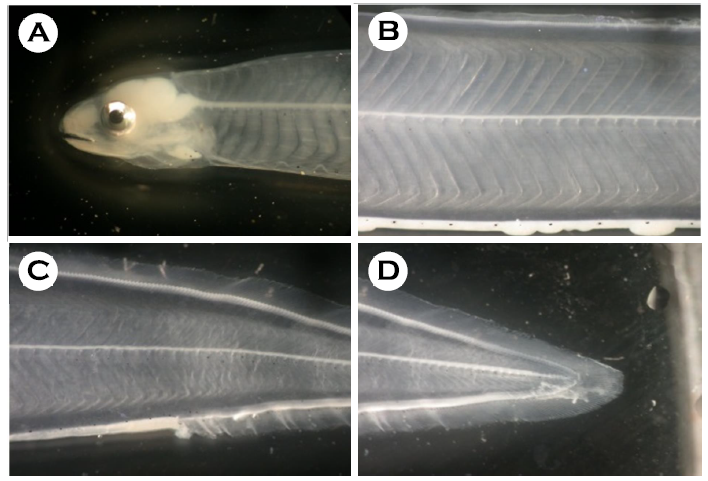
엽상자어의 계측 및 계수결과 평균은 전장 98.33 mm, 머리길이 7.67 mm, 뒷지느러미 기점거리 52.56 mm, 무게는 0.96 g, 척추골수는 144.96개였다(Table 2).

엽상자어가 실뱀장어 형태로 변태한 후 계측형질을 조사한 결과, 전장에 대한 머리길이의 백분비는 엽상자어 13.1%, 붕장어1 13.4%, 붕장어2 13.2%, 갯장어 14.8%, 극동산 뱀장어 10.9%, 필리핀산 뱀장어 11.6%, 미국산 뱀장어 12.7%, 유럽산 뱀장어 12.1%이었고, 전장에 대한 뒷지느러미 기점거리의 백분비는 엽상자어 35.6%, 붕장어1 39.7%, 붕장어2 39.7%, 갯장어 41.8%, 극동산 뱀장어 39.8%, 필리핀산 뱀장어 40.6%, 미국산 뱀장어 39.8%, 유럽산 뱀장어 42.9%였다(Table 3).
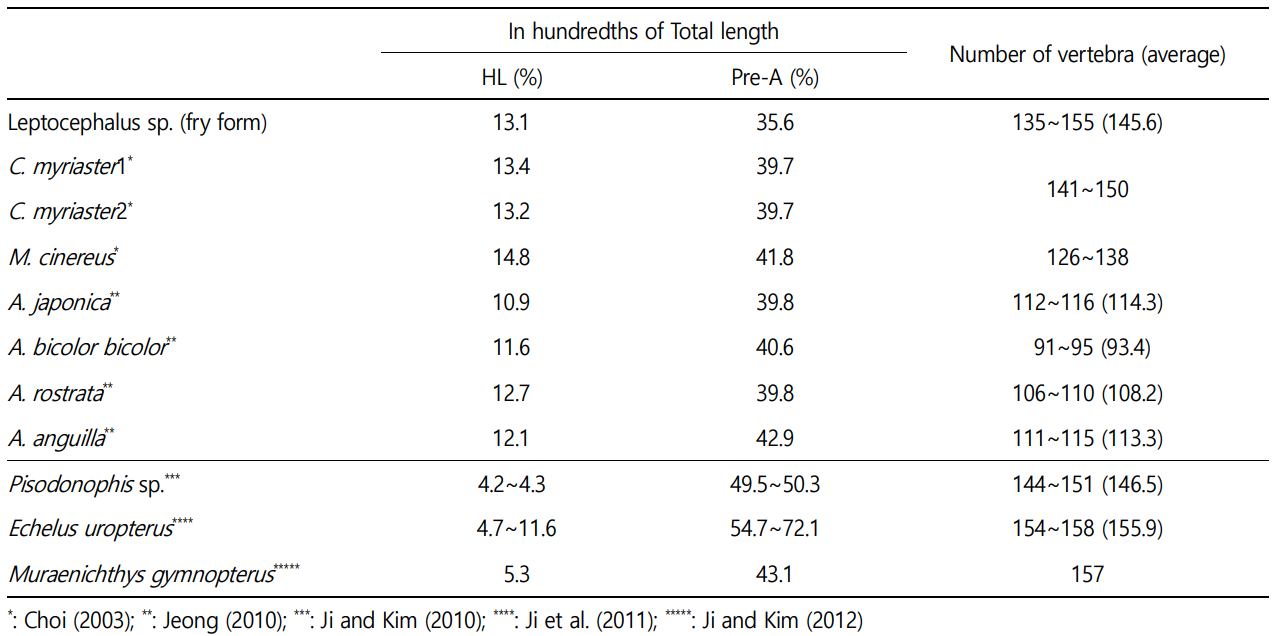
엽상자어, 붕장어, 갯장어 및 뱀장어속 4종의 미토콘드리아 DNA의 12S ribosomal RNA (16S rRNA) 유전자 영역을 NCBI에 등록된 뱀장어과, 곰치과, 붕장어과 어류 10종과 비교 및 분석한 결과 붕장어의 DNA와 100% 일치하였으며, 갯장어 81.3%, 극동산 뱀장어 83.1%, 필리핀산 뱀장어 81.5%, 미국산 뱀장어 83.1%, 유럽산 뱀장어 82.2%의 일치율를 보였고, 바닷물뱀과에 속하는 엽상자어 및 성어와 일치하는 종은 없었다(Table 4).
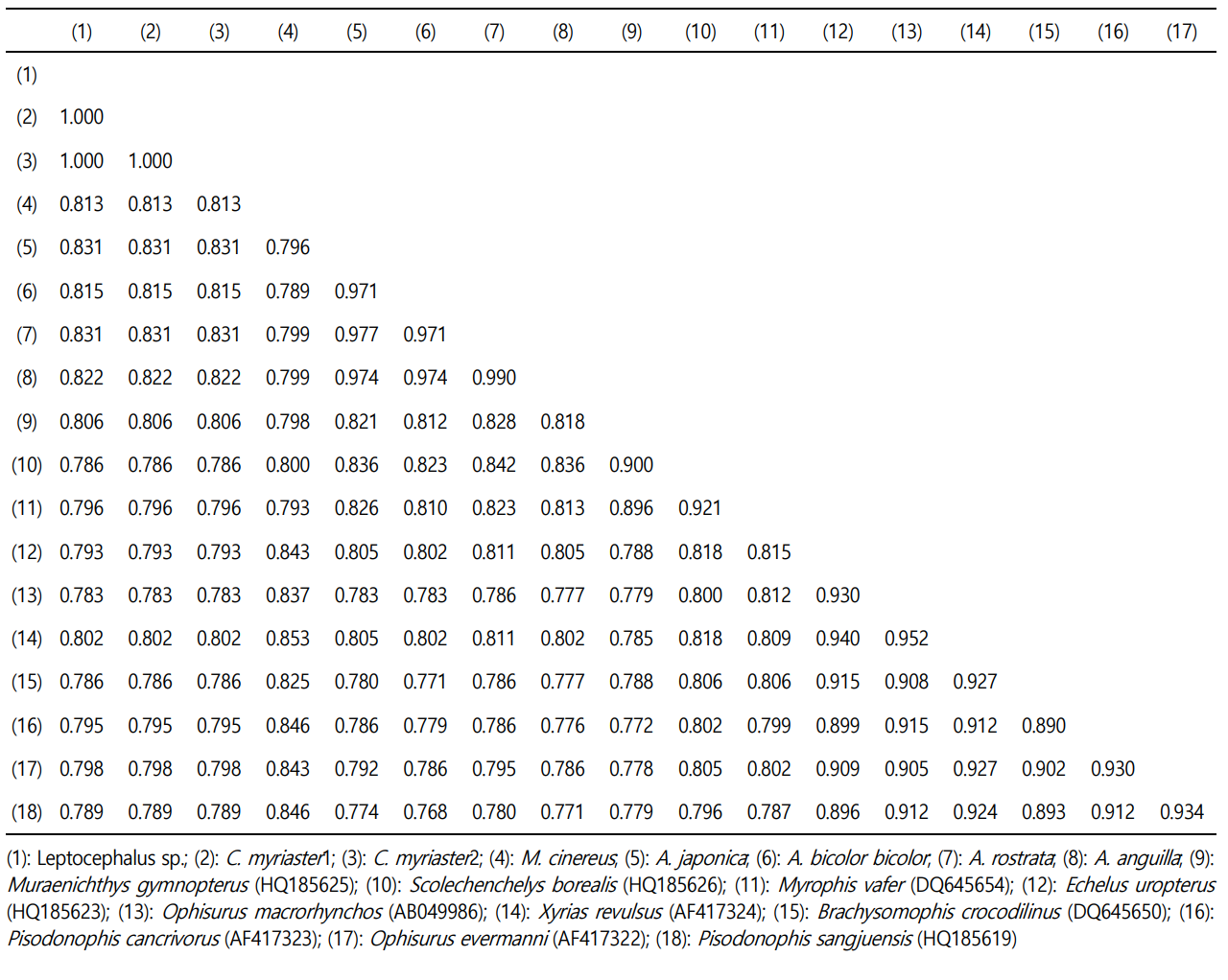
또한 분석된 염기배열에 기초한 계통수를 작성한 결과 역시 엽상자어와 붕장어가 유전적으로 일치하는 것을 확인할 수 있었고, 바닷물뱀과에 속하는 엽상자어 및 성어 역시 계통수상에서 유전적으로 거리가 있음을 확인하였다(Fig. 3).
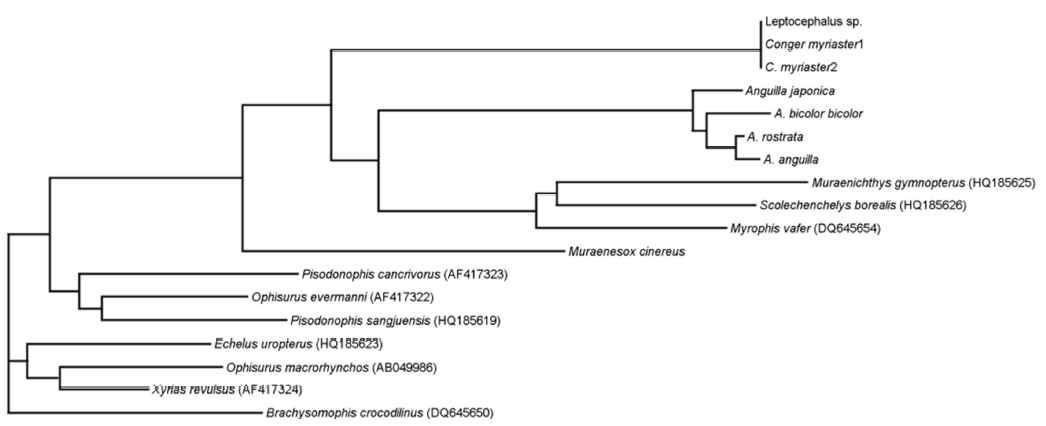
그리고 미토콘드리아 DNA의 16S ribosomal RNA (16S rRNA) 유전자 영역을 비교 및 분석한 결과 역시 붕장어의 DNA가 100% 일치하였으며, 갯장어 79.7%, 극동산 뱀장어 79.9%, 필리핀산 뱀장어 80.3%, 미국산 뱀장어 36.1%, 유럽산 뱀장어 79.6%의 일치율를 보였고, 뱀장어과, 곰치과, 붕장어과 어류와 일치하는 종은 없었다(Table 5).
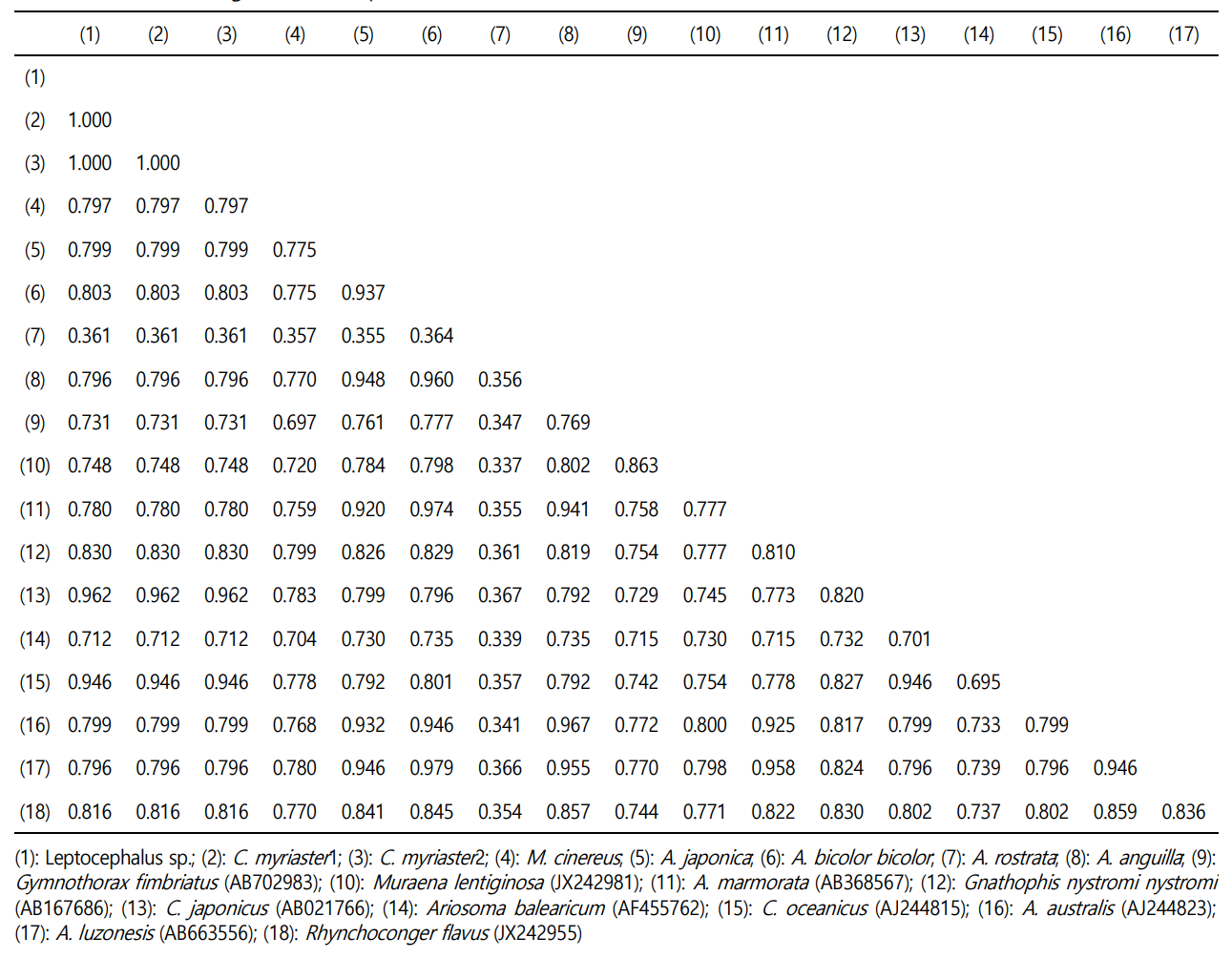
또한 분석된 염기배열에 기초한 계통수를 작성한 결과 역시 엽상자어와 붕장어가 유전적으로 일치하는 것을 확인할 수 있었고, 그 외에도 뱀장어과, 곰치과, 붕장어과 어류 10종 역시 계통수상에서 유전적으로 거리가 있음을 확인하였다(Fig. 4).
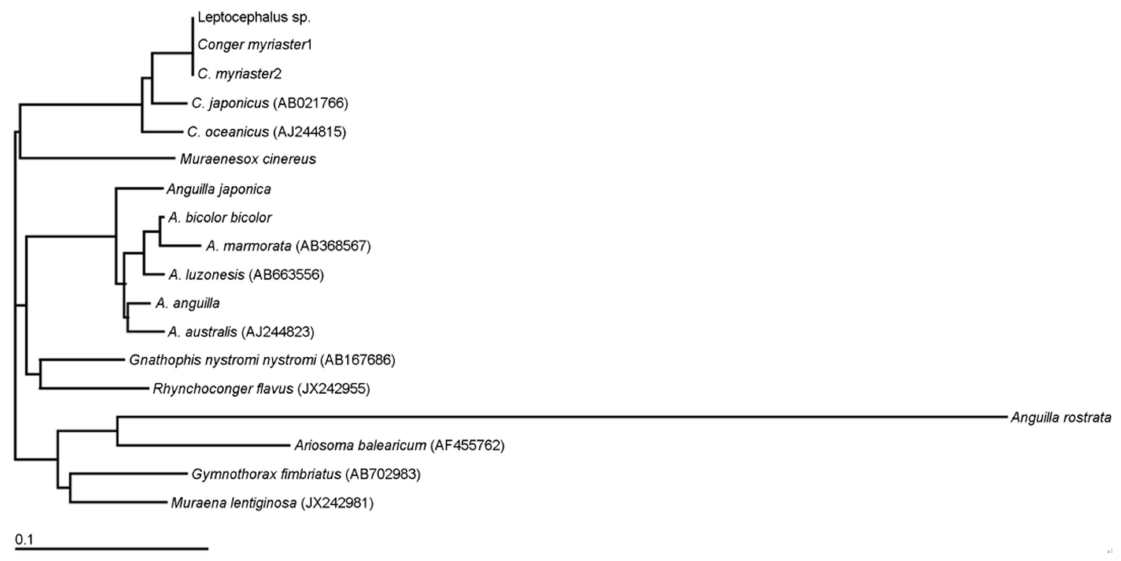
고 찰
이번 연구에 사용한 엽상자어의 몸통과 머리 모양은 붕장어와 뱀장어속 4종과 비슷하였으며, 윗턱에 비해 아래턱이 긴 뱀장어와는 달리 아래턱이 짧은 붕장어와 유사하였다. 이러한 형태적 특성은 바다뱀과 엽상자어(Ji and Kim, 2010)와 같이 상하로 측편되는 등 전체적은 몸통의 모양은 비슷했지만 주둥이 모양이 더 뾰족하였다. 날붕장어의 엽상자어 역시 전체적인 몸통의 모양은 비슷했지만 날붕장어의 엽상자어 머리 모양은 아래턱이 위턱보다 전방으로 돌출(Ji et al., 2011)되어 있는 반면에 붕장어의 엽상자어는 위턱이 아래턱보다 전방으로 돌출되어 차이를 보였다. 그리고 갯물뱀의 엽상자어 또한 아래턱이 위턱보다 돌출(Ji and Kim, 2012)되어 있어 붕장어의 엽상자어와 차이를 보였다. 따라서 형태상으로 보면 5~6월 남해에서 어획되는 엽상자어는 붕장어와 가장 유사하다고 할 수 있다.
전장에 대한 머리길이의 백분비는 붕장어와 비슷했고, Jeong (2010), Ji and Kim (2010), Ji et al. (2011), Ji and Kim (2012)의 뱀장어, 날붕자어, 갯물뱀과는 차이가 있었다.
엽상자어의 척추골수는 135~155개로 붕장어(141~150), 바다뱀과 엽상자어(144~151) (Ji and Kim, 2010), 갯물뱀(157) (Ji and Kim, 2012)과 비슷한 개수를 가지고 있었으며, 날붕장어(154~258) (Ji et al., 2011)와 극동산 뱀장어(112~116), 필리핀산 뱀장어(91~95), 미국산 뱀장어(106~110), 유럽산 뱀장어(111~115) (Jeong, 2010)와는 많은 차이를 보였다. 그러나 전장에 대한 두 장의 백분율은 13.1%로 붕장어1(13.4%), 붕장어2(13.2%)와 거의 비슷했고, 바다뱀과 엽상자어(4.2~4.3%) (Ji and Kim, 2010), 날붕장어(4.7~11.6%) (Ji et al., 2011), 갯물뱀(5.3) (Ji and Kim, 2012) 및 극동산 뱀장어(10.9%), 필리핀산 뱀장어(11.6%), 미국산 뱀장어(12.7%), 유럽산 뱀장어(12.1%) (Jeong, 2010)와도 차이를 보였다. 전장에 대한 뒷지느러미 기점거리의 백분율 역시 35.6%로 붕장어1, 2(39.7%)와 가장 비슷했으며, 바다뱀과 엽상자어(49.5~50.3%) (Ji and Kim, 2010), 날붕장어(54.7~72.1%) (Ji et al., 2011), 갯물뱀(43.1 )(Ji and Kim, 2012) 및 극동산 뱀장어(39.8%), 필리핀산 뱀장어(40.6%), 미국산 뱀장어(39.8%), 유럽산 뱀장어(42.9%) (Jeong, 2010)와도 차이를 보였다.
유전학적 특성을 알아내는데 사용한 미토콘드리아 DNA (mt DNA)는 염기치환에 의한 진화 속도가 빠르고 종내 연속적인 변이가 나타나며(Brown et al., 1979; Cann and Wilson, 1983), 종내 ·종간의 변화의 관찰과 유연관계를 파악하는데 효율적인 것으로 알려져 있다(Upholt and Dawid, 1977; Brown, 1980; Zhu er al., 1994; Kim, 1995). 이번 연구에서 엽상자어 DNA의 12S 및 12S ribosomal RNA를 분석한 결과 붕장어의 DNA가 100% 일치하였으며, 비교 그룹으로 이용한 Ji and Kim (2010), Ji et al. (2011), Ji and Kim (2012)에 보고된 바닷물뱀과에 속하는 어류와 날붕장어, 뱀장어과, 곰치과, 붕장어과 어류 등의 DNA (NCBI)와 비교한 했을때, 일치하는 종은 없었다. 또한 염기배열에 기초한 계통수를 작성한 결과 역시 엽상자어와 붕장어가 유전적으로 일치하는 것을 확인할 수 있었고, 다른 어류와는 계통수상에서 유전적으로 거리가 있음을 확인하였다.
그리고 엽상자어, 붕장어, 갯장어 및 뱀장어속 4종의 미토콘드리아 DNA의 16S ribosomal RNA (16S rRNA) 유전자 영역의 5' 말단 쪽 부분단편(약 600 bp)의 염기배열을 결정하고, NCBI에 등록된 10종과 비교 및 분석하였다. 12S rRNA 영역에서 어류의 종간 유전적 차이가 적어도 1% 이상인 점에서 종 동정의 유용한 분자마커이다(Ji and Kim, 2012). 이번 연구에 사용한 16S rRNA 역시 종간 유전적 차이가 1% 이상인 것으로 나타났으며, 12S rRNA와 함께 종 동정을 위한 유용한 분자마커로 사료된다.
Kim et al. (2005), Ji and Kim (2010), Ji et al. (2011), Ji and Kim (2012), Lee et al. (2013)의 연구에서 엽상자어는 7~10월 남해, 동해와 제주의 주변해역에서도 발견되고 있어, 이와 관련하여 월별 엽상자어의 출현과 종 동정과 이들 무리의 자치어 생태 등 지속적인 연구 수행이 필요하다고 사료된다.
본 연구를 통해 5~6월 남해에서 어획되는 엽상자어는 붕장어로 사료되며, 이 시기에 어획되는 엽상자어의 보호를 통해 붕장어 자원의 관리가 필요하다고 생각된다.
- References
-
1. Brown WM, George JG, Wilson AC. 1979. Rapid evolution of animal mitochondrial DNA. Proc. Natl Acad Sci USA 76: 967-1971.
-
2. Brown WM. 1980. Polymorphism in mitochondrial DNA of human as reversed by restriction endonuclease analysis. Proc Natl Acad Sci USA 77: 3605-3609.
-
-
4. Cheng Q, Zheng B. 1987. Systmeatic synopsis of Chinese fishes. Ⅰ, Ⅱ. Science Press, 100-103: 365-378.
-
-
6. Hatooka K. 1993. Fishes of Japan. In: with Pictorical Keys to the Species. Nakabo T, ed. Tokai Univ. Press, Tokyo, Japan, 186-190.
-
7. Jeong DH. 2010. Morphological and Genetic Classifications of Far-Eastern, European, American, and Southeast Asian eels. Chonnam National Univ, 29.
-
8. Ji HS, Kim JK. 2010. Molecular and Morphological Identification of Ophichthid Leptocephali from the South Sea of Korea. Korean J Ichthyol 22: 279-284.
-
9. Ji HS, Lee SJ, Kim JK. 2011. Molecular Identification, Ontogeny and Evolutionary Note of Echelus uropterus Leptocephali. Korean J Ichthyol 23: 217-224.
-
10. Ji HS, Kim JK. 2012. Molecular and Morphological Identification of a Muraenichthys gymnopterus (Ophichthidae: Anguilliformes) Leptocephalus Collected on Jeju island, Korea. Korean J Fish Aquat Sci 45: 507-512.
-
11. Kim BJ, Go YB, Nakaya K. 2005. A Leptocephalus Larva of Elops hawaiensis (Elopiformes: Elopidae) from Jeju Island, Korea. Korea J Ichthyol 17(3): 217-220.
-
12. Kim KH. 1995. The analysis of mtDNA using restriction endo- nucleases in Korean toad, Bufo bufo. Ph.D. Thesis, Inha University of Incheon, Korea, 25.
-
-
14. Lee CL, Park MH. 1994. Classification and morphology of the family Congridae (Anguiligormes) from Korea. Kor J Ichthyol 6: 132-159.
-
15. Lee SJ, Ji HS, Kim JK. 2013. Molecular Indentification and Mor- phological Description of Gymnothorax minor (Muraenidae, Anguilliformes) Leptocephali off Jeju Island. Korean J Ichthyol 25: 59-64.
-
16. Miya M, Nishida M. 1999. Organization of the mitochondrial genome of a deep sea fish, Gonostoma gracile (Teleostei: Stomiiformes): first example of transfer RNA gene rearrange- ments in bony fishes. Mar Biotechnol 1: 416-426.
-
-
18. NFRDI. 2004. Commercial Fishes of the coastal & offshore waters in Korea. National Fisheries Research and Development In- stitute. Han-Geul Publish, 333.
-
-
20. Tesch FW. 1977. The Eel. Biology and management of anguilld eels. Chapman and Hall, Longon, 434.
-
21. Tzeng WN, Tabeta O. 1983. First record of the short-finned eel Tzeng WN, Tabeta O. 1983. First record of the short-finned eel Anguilla bicolor pacifica elvers from Taiwan. Bull Jap Soc Sci Fish 49: 27-32.
-
22. Upholt WB, Dawid IB. 1977. Estimation of DNA sequence diver- gence from comparison of restriction endonuclease digests. Nucleic Acids Res 4: 1257-1266.
-
23. Zardoya RA, Pertierra G, Bautista JM. 1995. The complete nuclo- tide sequence of the mitochondrial DNA genome of the rainbow trout, Oncorhynchus mykiss. J Mol Evol 41: 942-951.
-
24. Zhu D, Jamieson BGM, Hugall A, Moritz C. 1994. Sequence evolution and Phylogenetic signal in control region and cytochrome b sequence of rainbow fishes (Nelano taeniidae). Mol Biol vol 11: 672-683.












